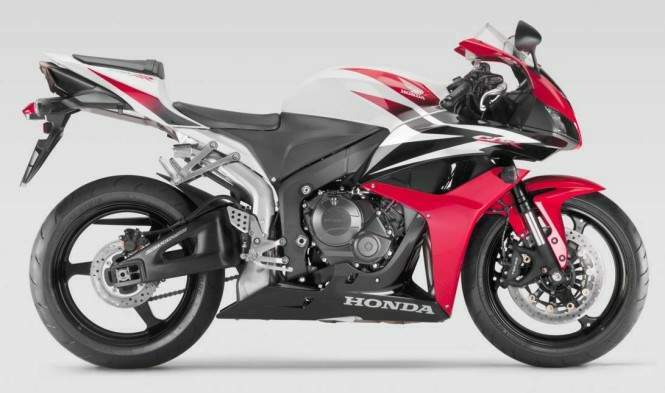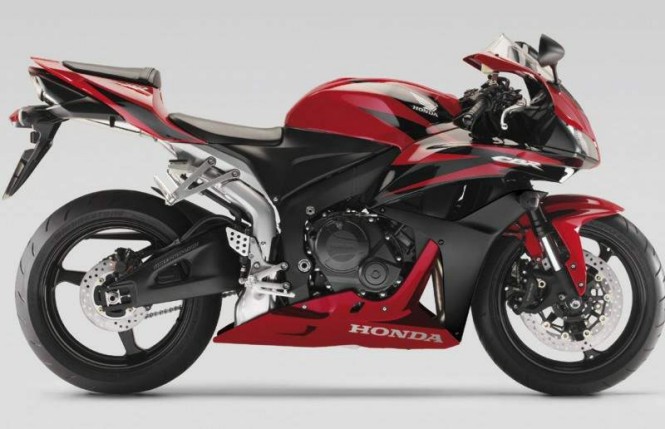
Make Model | Honda CBR 600RR |
Year | 2008 |
Engine | Liquid cooled, four stroke, transverse four cylinder, DOHC, 4 valve per cylinder. |
Capacity | 599 |
Bore x Stroke | 67 x 42.5 mm |
Compression Ratio | 12.2:1 |
Induction | PGM-DSFi fuel-injection with |
Ignition / | Computer-controlled digital transistorized with electronic advance and independent four-cylinder 3D-mapped computer control. / electric |
Clutch | Cable-operated multiplate wet clutch. |
Max Power | 118 hp 88.1 KW @ 13500 rpm |
Max Torque | 66 Nm @ 11250 rpm |
Transmission / | 6 Speed / chain |
Front Suspension | 41mm inverted HMAS cartridge fork with spring preload, rebound and compression damping adjustability, 120mm wheel travel |
Rear Suspension | Unit Pro-Link HMAS single shock with spring preload, rebound and compression damping adjustability, 129.5mm wheel travel |
Front Brakes | 2x 320mm discs 4 piston calipers |
Rear Brakes | Single 220mm disc 1 piston caliper |
Front Tyre | 120/70 ZR17 |
Rear Tyre | 180/55 ZR17 |
Seat Height | 820 mm |
Dry-Weight | 156.5 kg |
Fuel Capacity | 18.2 Litres |
Standing 1000 m | 20.6 sec / 243.9 km/h |
Standing | 11.1 sec / 207.3 km/h |
Top Speed | 253.9 km/h |

A lighter crank and lighter con-rods means lighter — and smaller —
everything else, so the entire package — capped off with 11-ounce lighter
magnesium valve covers — measures up as 27.5mm shorter than the 2006, all
the while making more power and torque and weighing in at 3.7 pounds less.
“The clutch is
lighter, smaller and stronger, and the transmission gets closer ratios and a
redesign to reduce driveline lash.”
Engine improvements don’t stop there. We didn’t complain about last
year’s clutch or transmission, but Honda improved them anyway. The clutch is
lighter, smaller and stronger, and the transmission gets closer ratios and a
redesign to reduce driveline lash. There’s also a new gadget called the
Intake Air Control Valve (IACV), which smoothes throttle response, avoiding
the jerky fuel injection-induced response some other motorcycles are cursed
with.
The airbox — which now sucks air through a hole in the front of the frame
like the RC-51 — gains seven percent of additional capacity, and the
radiator is 40mm narrower, but 34.2mm taller so not too much frontal area is
lost. The exhaust now has titanium baffles; they could have put that
bling-bling on display like some OEMs do, but they put it inside where it
would do the most good.
Suspension and brakes are standard, if effective, fare. In front, a
fully-adjustable (except for high-speed settings) 41mm inverted fork and
four-piston radial-mount calipers get the job done, (although Toland said
the new braking components offer more sensitivity) and in the rear the Honda
Unit Pro-Link is bolted to the three-way-adjustable shock. The Unit Pro Link
shock linkage is GP-tech for the street; it isolates the suspension almost
totally from the frame to ensure the smoothest possible ride.
A Honda Electronic Steering Damper (HESD) that’s half the size (and 20
percent lighter) of last year’s damper keeps the compact chassis — with a
steeper rake than the old machine’s — under control by adjusting damping
force according to speed.
To wrap up the package, the Honda stylists added a thicker seat (although
it’s roadcourse as a DOT race tire on dry pavement would be. I say
“probably” because I didn’t want to be that guy who pushed it too hard in
the rain and crunched a brand-new bike: I was happy at an 8/10ths pace.
The increased traction meant I could settle down and really get a feel
for the machine’s suspension, braking and other qualities. With a team of
Honda technicians on hand to ensure a perfect set-up, the suspension felt
spot-on, even though they misunderestimated my weight by 20 pounds. Although
the track is very smooth, there are some pavement ripples in one high-speed
braking zone (thanks, Grand Am cars!) that translated into some choppiness,
but I imagine any motorcycle would get bounced around there.Accelerating off
of Turn Six down the back straight, the front end gets light but the HESD
damper works fine and there’s no drama.
Serious sportbike pilots have eagerly anticipated the arrival of the
potent new 2007 CBR600RR, and now the industry experts have confirmed this
incredible machine was well worth the wait. Cycle News crowned this
middleweight missile winner of its ‘07 600cc Class Shootout, with the more
compact, more powerful and lighter-weight 600RR easily besting the
competition on both track and street. Roadracing World went one
better, calling the CBR600RR “the best 600cc sportbike ever.” Praise doesn’t
come much higher. And neither does performance.


















0 comments:
Post a Comment